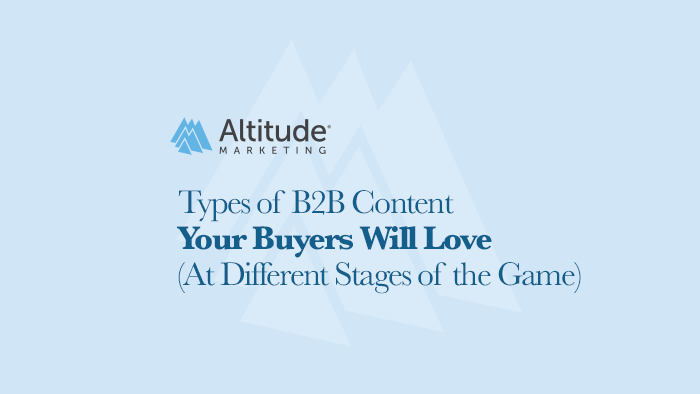At different stages of the buyer journey, buyers are more willing to consume different types of B2B content at varying lengths. Here’s how to make sure you have all your content bases covered.
You have your reasons for writing content. Brand awareness. Website traffic. Lead generation. But your buyers have entirely different reasons for wanting to read your content.
And it all depends on what stage of the buyer’s journey they are in.
First, let’s talk about why you need different types of B2B content to begin with.
Why You Need Different Types of B2B Content
As you develop a B2B content strategy, your first step is to identify who your audience is and what they want to know.
Using what you have then learned about your audience, you can then come up with the types of B2B content you plan to produce, as well as a universe of topics. These should all be designed to address the questions your buyers have at each stage of the process, which means you need more than one type of content. (So, more than just blogs!)
This is because your audience has varying needs and amounts of time to consume content.
So, the types of B2B content you need to include in your strategy must cover at least 3 approximate stages: the early stages (top-funnel), middle stages (learning) and later stages (bottom-funnel).

Content for Early Stages
The early stages, or top of funnel, is when your buyer is just starting out. Their questions might be more high level, which means they expect and seek higher-level answers. Because of this, they are probably less willing to spend more time consuming your content. They don’t know (or trust) you yet.
At this stage of the game, buyers are simply identifying problems they may be facing. So, it’s important to speak to regular industry problems (that your product/service solves) and answer it in a non-self-promotional way. The following types of B2B content work best for this:
- Infographics: A quick hitting visual infographic that’s easy to consume and understand quickly.
- Podcasts: Educational, entertaining and easy to listen to while doing something else, like driving or doing the dishes.
- Media/Trade Pubs: Articles from sources your buyers already know and trust.
- eBooks: Simple, designed pieces of content that answer questions in an engaging way. More accessible than a technical white paper.
- Newsletters: Emails are short and sweet and (should) offer immediate value, perfect for someone just starting out.
The key with early-stage buyers is short, genuinely helpful pieces of content that are easy to access, read (or listen to) and understand.
Content for Middle Stages
In the middle stages, your buyer is learning more and exploring potential answers. They might be more familiar with your brand and offering. So, they are more willing to spend a bit more time consuming your content.
They know they have a problem (because you hopefully educated them at the early stage!) and they are more actively searching for solutions.
Since they’re more invested in learning, these types of content work well:
- Blogs: Medium sized articles that comprehensively answer one question.
- Webinars: Educational videos that show a solution (not a product demo, though) or a Q&A with a customer.
- Third party analyst reports: Objective reviews of a product offering from trusted sources, like Gartner.
- White papers: In-depth, long form guide that informs readers about a complex problem and helps them understand it, solve it or make a decision about it. Buyers will typically exchange an email address for a white paper.
- Case studies: A real-world example of how you solved someone’s problem, with more emphasis on the success of the client you helped.
The key here is to continue to offer helpful pieces of content that aren’t overly self-promotional, but, as they learn more and weigh their options, give them opportunities to envision what it would be like to work with you.
Content for Late Stages
In the late stages, your buyer is actively looking for a solution. They probably have a list of potential companies and are ready to make an informed purchase decision. This is a big deal in the B2B space and is not taken lightly.
So, be a good partner and give the prospect as much information as you can about what it’s like to work with you. Inform them well so they can make the right decision for their company – which will hopefully be the right decision for you, too.
You can accomplish this with:
- ROI calculators: Give them a way to quantify their decision.
- Colleagues & peers: Your potential buyer will ask around to see what their colleagues and peers think. Hopefully your content has reached these people, too.
- Third party analyst reports
- Case studies
These types of B2B content slightly overlap with the middle stage—and that’s okay. It’s a fluid process. You want to provide as much information as possible and guide your buyer through the funnel.
tl;dr: Types of B2B Content
At a high level, B2B buyers want value, which means less product-specific information. They also want content from trustworthy sources that reference data and research to support their claims. As buyers get closer to the decision point, they are more open to product information because they (hopefully) recognize you as a trusted source.
The important part is providing as much information as you can across varying levels of depth to appeal to all potential buyers—their interest levels, time limitations and mediums they prefer.
So long as you produce a good mix of content types at a consistent cadence, you will have something for everyone!



